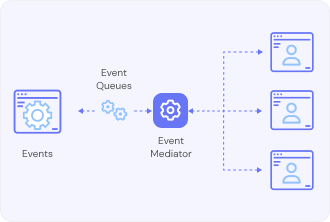Event Driven Definition

Any person related to software development would definitely across the term “event driven” very frequently. But what does that really mean? Event-driven architecture means a design paradigm wherein, in general, the flow of a program depends on events—events either user actions, sensor outputs, or messages coming from other programs.
This style consists of quite a large and important constituent for modern software development, having a lot to do with flexibility and responsiveness. It considers the detailed concept of event-driven architecture for software development, together with the associated benefits.
Driven Event Architecture
The base of event-driven architecture is the “event.” Put simply, an event might be thought of as a state change for something. This includes everything from a mouse click and a keystroke to anything from a sensor signal. An event handler is any area of code called in response to an event occurring.
An overview example would be the event of a button click in a user interface. The system will catch the event and execute the code bound to said event—for instance, opening a new window or probably submitting a form. This gives applications a lively interactive way of working due to its reactive approach.
Overall, every event-driven system will include these three integral components: an event producer, an event channel, and an event consumer. Producers produce events and channels transport them, while consumers respond to the same very events. But this separation makes dealing with and scaling a system easier.
Event Driven Software Development
Event-driven architecture is a very useful design in software development for developing systems that want to respond efficiently to several events. This is commonly the case in real-time applications, like trading platforms, IoT systems, and UI.
The other advantage of using event-driven architecture in software development is for decoupling components. Various parts of the system work independently and therefore communicate only on events. Because of this decoupling, more modular and maintainable code is created. For example, within a large-scale application, a user interface might be designed independent of business logic since they are communicating through events.
Second, event-driven architecture makes the system more scalable. This is because, in this architecture, components are decoupled, allowing them to scale independently of one another. Should some particular service require more resources to process an increasing amount of events, it might be scaled without influencing other components or system parts. This degree of flexibility comes particularly in handy when apps have variable loads to bear.
Benefits of Even Driven Architecture
Understanding event-driven architecture also means understanding the challenges associated with it. One big challenge is complexity in management events, mostly where large-scale systems are run and there are several activities happening at almost every instance. Availing these events to process in a proper order and handling probable race conditions or any other type of conflict requires careful design and robust testing.
The other challenge is in debugging and monitoring: by its very nature, flow of control is complex and not evident within an event-driven system. For example, the firings of the events are potentially asynchronous; therefore, tracing the sequence of events, for diagnosing problems, may become very difficult. Tools and frameworks for log analysis, monitoring, and tracing are of key importance to master this complexity.
Though not easy to use, event-driven architecture usually enjoys many advantages over its little disadvantages. Making responsive, scalable, and flexible systems makes event-driven architecture a choice for too many software development projects.
Conclusion
The event-driven architecture makes feasible a very powerful design paradigm for the creation of sensitive and scalable software systems. This development approach, with events being the primary means to trigger actions within a system, provide more modular, easier-to-maintain system capable of handling complex and real-time interactions.
Whether it is a ‘button click’ by a user, data sent by a sensor, or an incoming message from another system, event-driven architecture allows software to respond quickly and in an efficient way. However, considering the troubles in event flow management and debugging, its benefits outweigh the costs of this valuable approach to modern software development.
It will drive the construction of more solid and flexible systems, making sure that each application is responsive to a given load and condition. In the future, when technology finally shows no signs of ever stopping in advancement, the principles of event-driven design undeniably would still have their vital roles in coming up with new innovative software solutions.